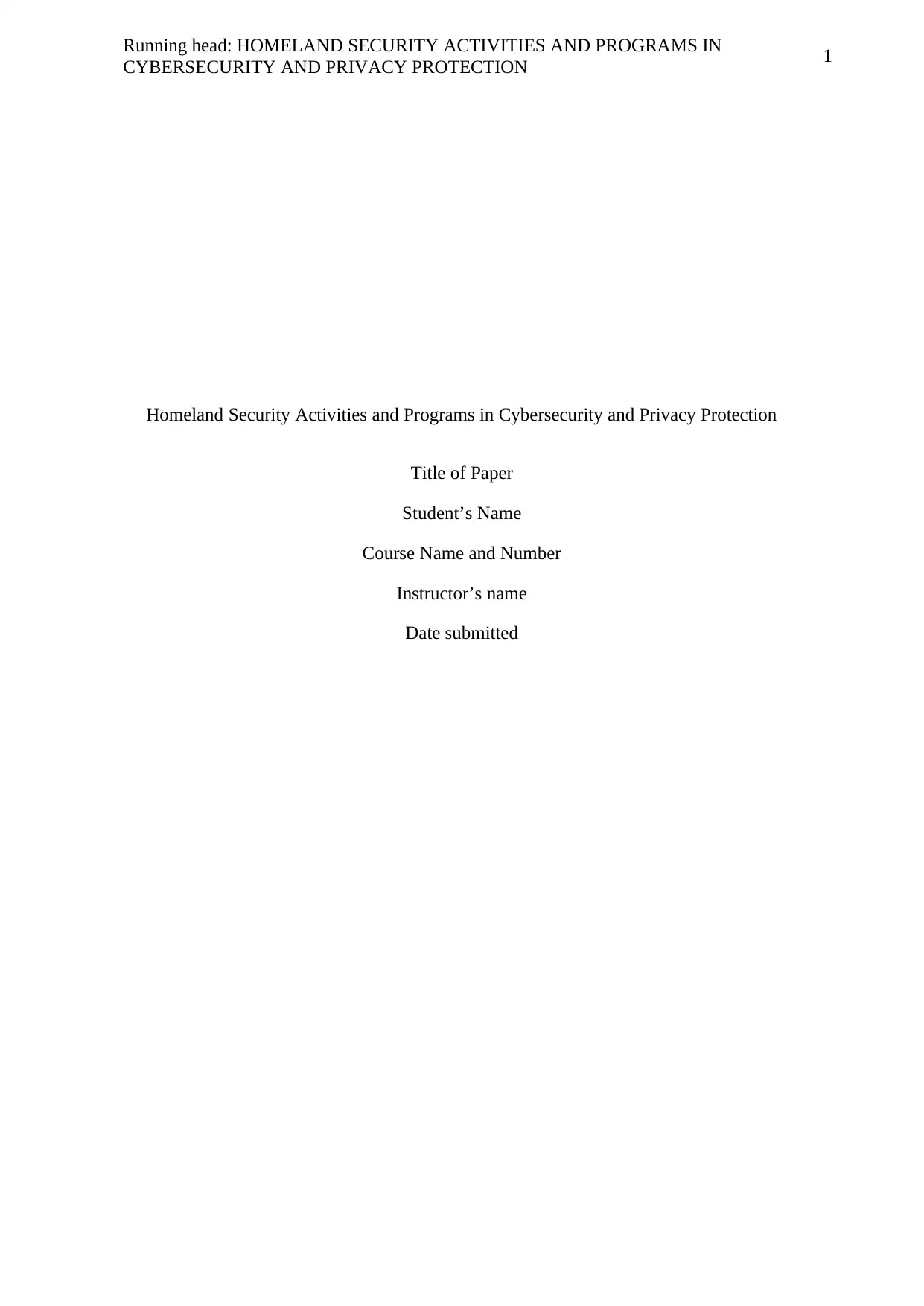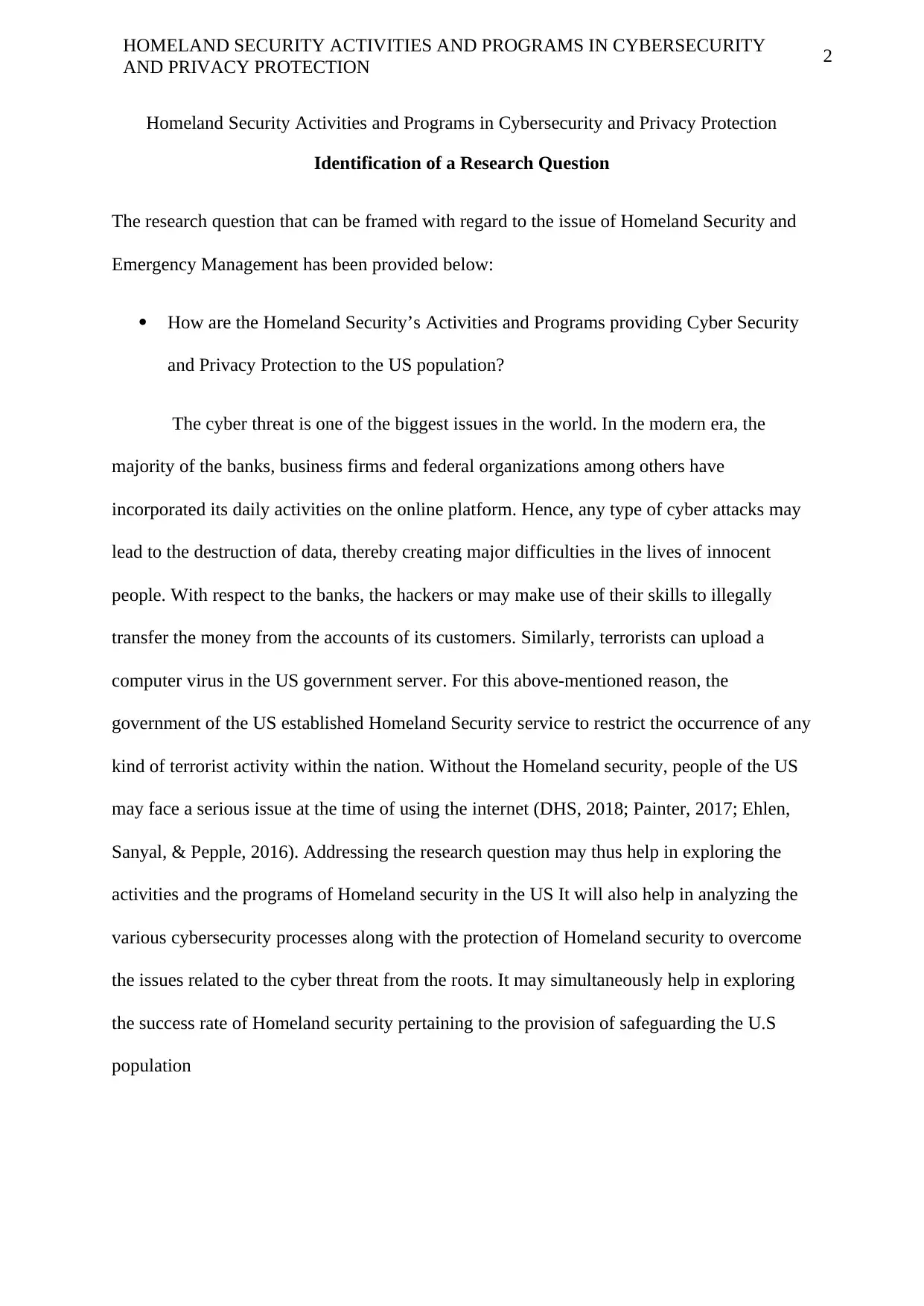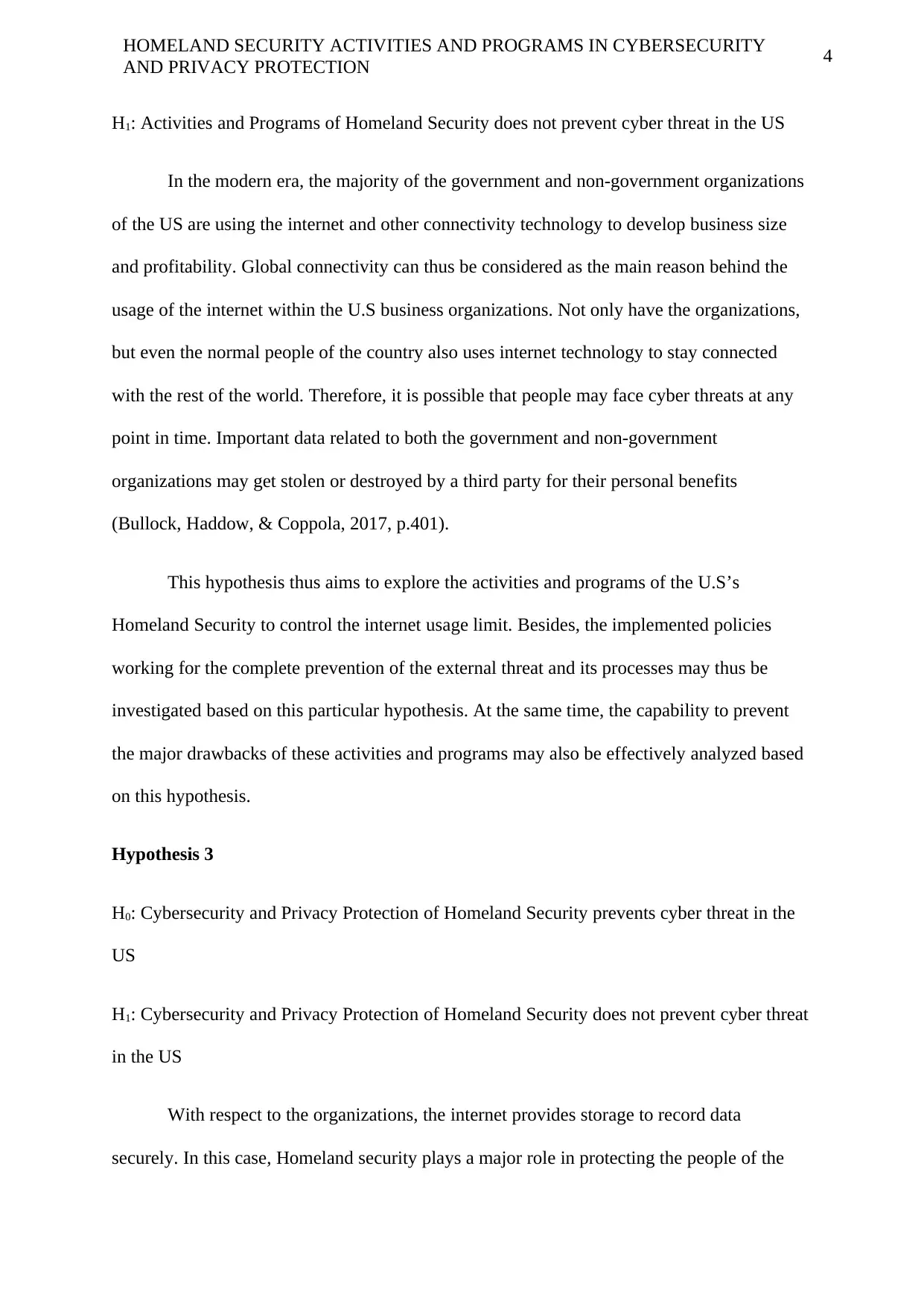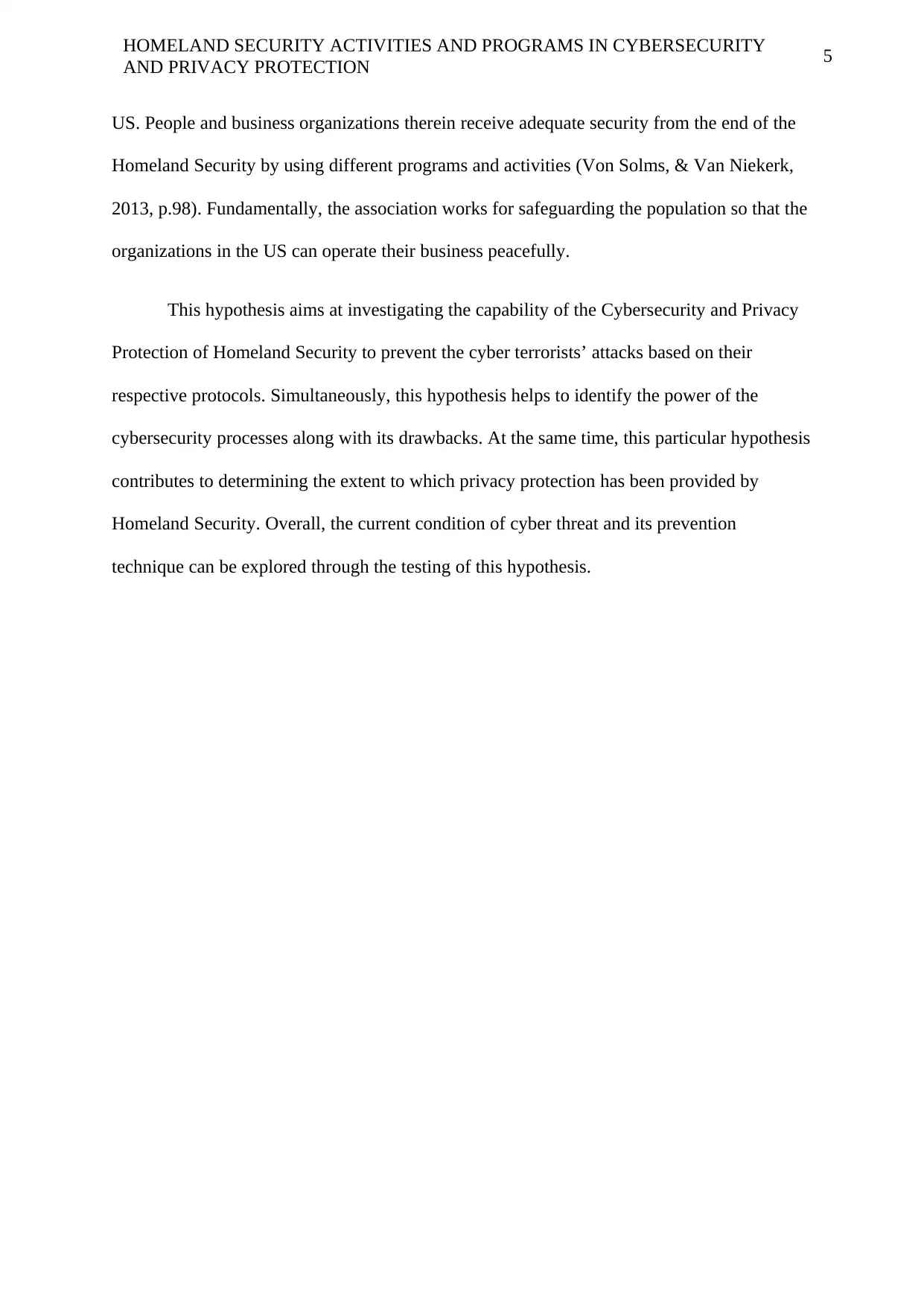HSM 497: Cybersecurity and Privacy Protection in Homeland Security
VerifiedAdded on 2023/05/30
|6
|1265
|255
Report
AI Summary
This report delves into the activities and programs of Homeland Security concerning cybersecurity and privacy protection within the United States. It begins by identifying a key research question: "How are the Homeland Security’s Activities and Programs providing Cyber Security and Privacy Protection to the US population?" The paper then formulates three research hypotheses, exploring the effectiveness of Homeland Security in providing security against cyber threats, preventing such threats through its activities and programs, and the role of cybersecurity and privacy protection in these efforts. The report examines the impact of cyber threats on various sectors, including banks, businesses, and government organizations, and highlights the importance of Homeland Security in mitigating these risks. The analysis covers the role of Homeland Security in preventing cyber terrorism, safeguarding data, and protecting the privacy of US citizens. The report concludes with a comprehensive list of references, providing context for the research. The research investigates the protection provided by Homeland Security and its capabilities in preventing cyber threats and the degree to which privacy protection has been provided.

1
Running head: HOMELAND SECURITY ACTIVITIES AND PROGRAMS IN
CYBERSECURITY AND PRIVACY PROTECTION
Homeland Security Activities and Programs in Cybersecurity and Privacy Protection
Title of Paper
Student’s Name
Course Name and Number
Instructor’s name
Date submitted
Running head: HOMELAND SECURITY ACTIVITIES AND PROGRAMS IN
CYBERSECURITY AND PRIVACY PROTECTION
Homeland Security Activities and Programs in Cybersecurity and Privacy Protection
Title of Paper
Student’s Name
Course Name and Number
Instructor’s name
Date submitted
Paraphrase This Document
Need a fresh take? Get an instant paraphrase of this document with our AI Paraphraser

2
HOMELAND SECURITY ACTIVITIES AND PROGRAMS IN CYBERSECURITY
AND PRIVACY PROTECTION
Homeland Security Activities and Programs in Cybersecurity and Privacy Protection
Identification of a Research Question
The research question that can be framed with regard to the issue of Homeland Security and
Emergency Management has been provided below:
How are the Homeland Security’s Activities and Programs providing Cyber Security
and Privacy Protection to the US population?
The cyber threat is one of the biggest issues in the world. In the modern era, the
majority of the banks, business firms and federal organizations among others have
incorporated its daily activities on the online platform. Hence, any type of cyber attacks may
lead to the destruction of data, thereby creating major difficulties in the lives of innocent
people. With respect to the banks, the hackers or may make use of their skills to illegally
transfer the money from the accounts of its customers. Similarly, terrorists can upload a
computer virus in the US government server. For this above-mentioned reason, the
government of the US established Homeland Security service to restrict the occurrence of any
kind of terrorist activity within the nation. Without the Homeland security, people of the US
may face a serious issue at the time of using the internet (DHS, 2018; Painter, 2017; Ehlen,
Sanyal, & Pepple, 2016). Addressing the research question may thus help in exploring the
activities and the programs of Homeland security in the US It will also help in analyzing the
various cybersecurity processes along with the protection of Homeland security to overcome
the issues related to the cyber threat from the roots. It may simultaneously help in exploring
the success rate of Homeland security pertaining to the provision of safeguarding the U.S
population
HOMELAND SECURITY ACTIVITIES AND PROGRAMS IN CYBERSECURITY
AND PRIVACY PROTECTION
Homeland Security Activities and Programs in Cybersecurity and Privacy Protection
Identification of a Research Question
The research question that can be framed with regard to the issue of Homeland Security and
Emergency Management has been provided below:
How are the Homeland Security’s Activities and Programs providing Cyber Security
and Privacy Protection to the US population?
The cyber threat is one of the biggest issues in the world. In the modern era, the
majority of the banks, business firms and federal organizations among others have
incorporated its daily activities on the online platform. Hence, any type of cyber attacks may
lead to the destruction of data, thereby creating major difficulties in the lives of innocent
people. With respect to the banks, the hackers or may make use of their skills to illegally
transfer the money from the accounts of its customers. Similarly, terrorists can upload a
computer virus in the US government server. For this above-mentioned reason, the
government of the US established Homeland Security service to restrict the occurrence of any
kind of terrorist activity within the nation. Without the Homeland security, people of the US
may face a serious issue at the time of using the internet (DHS, 2018; Painter, 2017; Ehlen,
Sanyal, & Pepple, 2016). Addressing the research question may thus help in exploring the
activities and the programs of Homeland security in the US It will also help in analyzing the
various cybersecurity processes along with the protection of Homeland security to overcome
the issues related to the cyber threat from the roots. It may simultaneously help in exploring
the success rate of Homeland security pertaining to the provision of safeguarding the U.S
population

3
HOMELAND SECURITY ACTIVITIES AND PROGRAMS IN CYBERSECURITY
AND PRIVACY PROTECTION
Formulation of Research Hypotheses
Hypothesis 1
H0: Homeland Security of America provides the population with adequate security against
Cyberthreat
H1: Homeland Security of America does not provide adequate security to the people against
Cyberthreat
Homeland Security can be regarded as a law enforcement agency of the US, which
works for the prevention of the terrorist attacks. Majorly, it has been observed that the
Homeland Security safeguards the US population from terrorism and its impacts in the short
as well as long run. In the recent era, cyber terrorism can be considered as one of the major
issues throughout the world. The US government has provided the required amount of
security on cyber crimes with the help of the agency associated with Homeland Security
(Kiltz, 2011).
Contextually, it needs to be noted that the Homeland Security of the US organizes
various activities as well as programs to provide the population therein with strong
cybersecurity and privacy protection. This hypothesis further aims to explore the
cybersecurity related operations of the Homeland Security so as to be able to prevent cyber
threats within the region. At the same time, the security limitations regarding cyber threats
and unexpected cyber risk prevention technique can also be explored based on the testing of
this hypothesis.
Hypothesis 2
H0: Activities and Programs of Homeland Security prevents cyber threat in the US
HOMELAND SECURITY ACTIVITIES AND PROGRAMS IN CYBERSECURITY
AND PRIVACY PROTECTION
Formulation of Research Hypotheses
Hypothesis 1
H0: Homeland Security of America provides the population with adequate security against
Cyberthreat
H1: Homeland Security of America does not provide adequate security to the people against
Cyberthreat
Homeland Security can be regarded as a law enforcement agency of the US, which
works for the prevention of the terrorist attacks. Majorly, it has been observed that the
Homeland Security safeguards the US population from terrorism and its impacts in the short
as well as long run. In the recent era, cyber terrorism can be considered as one of the major
issues throughout the world. The US government has provided the required amount of
security on cyber crimes with the help of the agency associated with Homeland Security
(Kiltz, 2011).
Contextually, it needs to be noted that the Homeland Security of the US organizes
various activities as well as programs to provide the population therein with strong
cybersecurity and privacy protection. This hypothesis further aims to explore the
cybersecurity related operations of the Homeland Security so as to be able to prevent cyber
threats within the region. At the same time, the security limitations regarding cyber threats
and unexpected cyber risk prevention technique can also be explored based on the testing of
this hypothesis.
Hypothesis 2
H0: Activities and Programs of Homeland Security prevents cyber threat in the US
⊘ This is a preview!⊘
Do you want full access?
Subscribe today to unlock all pages.

Trusted by 1+ million students worldwide

4
HOMELAND SECURITY ACTIVITIES AND PROGRAMS IN CYBERSECURITY
AND PRIVACY PROTECTION
H1: Activities and Programs of Homeland Security does not prevent cyber threat in the US
In the modern era, the majority of the government and non-government organizations
of the US are using the internet and other connectivity technology to develop business size
and profitability. Global connectivity can thus be considered as the main reason behind the
usage of the internet within the U.S business organizations. Not only have the organizations,
but even the normal people of the country also uses internet technology to stay connected
with the rest of the world. Therefore, it is possible that people may face cyber threats at any
point in time. Important data related to both the government and non-government
organizations may get stolen or destroyed by a third party for their personal benefits
(Bullock, Haddow, & Coppola, 2017, p.401).
This hypothesis thus aims to explore the activities and programs of the U.S’s
Homeland Security to control the internet usage limit. Besides, the implemented policies
working for the complete prevention of the external threat and its processes may thus be
investigated based on this particular hypothesis. At the same time, the capability to prevent
the major drawbacks of these activities and programs may also be effectively analyzed based
on this hypothesis.
Hypothesis 3
H0: Cybersecurity and Privacy Protection of Homeland Security prevents cyber threat in the
US
H1: Cybersecurity and Privacy Protection of Homeland Security does not prevent cyber threat
in the US
With respect to the organizations, the internet provides storage to record data
securely. In this case, Homeland security plays a major role in protecting the people of the
HOMELAND SECURITY ACTIVITIES AND PROGRAMS IN CYBERSECURITY
AND PRIVACY PROTECTION
H1: Activities and Programs of Homeland Security does not prevent cyber threat in the US
In the modern era, the majority of the government and non-government organizations
of the US are using the internet and other connectivity technology to develop business size
and profitability. Global connectivity can thus be considered as the main reason behind the
usage of the internet within the U.S business organizations. Not only have the organizations,
but even the normal people of the country also uses internet technology to stay connected
with the rest of the world. Therefore, it is possible that people may face cyber threats at any
point in time. Important data related to both the government and non-government
organizations may get stolen or destroyed by a third party for their personal benefits
(Bullock, Haddow, & Coppola, 2017, p.401).
This hypothesis thus aims to explore the activities and programs of the U.S’s
Homeland Security to control the internet usage limit. Besides, the implemented policies
working for the complete prevention of the external threat and its processes may thus be
investigated based on this particular hypothesis. At the same time, the capability to prevent
the major drawbacks of these activities and programs may also be effectively analyzed based
on this hypothesis.
Hypothesis 3
H0: Cybersecurity and Privacy Protection of Homeland Security prevents cyber threat in the
US
H1: Cybersecurity and Privacy Protection of Homeland Security does not prevent cyber threat
in the US
With respect to the organizations, the internet provides storage to record data
securely. In this case, Homeland security plays a major role in protecting the people of the
Paraphrase This Document
Need a fresh take? Get an instant paraphrase of this document with our AI Paraphraser

5
HOMELAND SECURITY ACTIVITIES AND PROGRAMS IN CYBERSECURITY
AND PRIVACY PROTECTION
US. People and business organizations therein receive adequate security from the end of the
Homeland Security by using different programs and activities (Von Solms, & Van Niekerk,
2013, p.98). Fundamentally, the association works for safeguarding the population so that the
organizations in the US can operate their business peacefully.
This hypothesis aims at investigating the capability of the Cybersecurity and Privacy
Protection of Homeland Security to prevent the cyber terrorists’ attacks based on their
respective protocols. Simultaneously, this hypothesis helps to identify the power of the
cybersecurity processes along with its drawbacks. At the same time, this particular hypothesis
contributes to determining the extent to which privacy protection has been provided by
Homeland Security. Overall, the current condition of cyber threat and its prevention
technique can be explored through the testing of this hypothesis.
HOMELAND SECURITY ACTIVITIES AND PROGRAMS IN CYBERSECURITY
AND PRIVACY PROTECTION
US. People and business organizations therein receive adequate security from the end of the
Homeland Security by using different programs and activities (Von Solms, & Van Niekerk,
2013, p.98). Fundamentally, the association works for safeguarding the population so that the
organizations in the US can operate their business peacefully.
This hypothesis aims at investigating the capability of the Cybersecurity and Privacy
Protection of Homeland Security to prevent the cyber terrorists’ attacks based on their
respective protocols. Simultaneously, this hypothesis helps to identify the power of the
cybersecurity processes along with its drawbacks. At the same time, this particular hypothesis
contributes to determining the extent to which privacy protection has been provided by
Homeland Security. Overall, the current condition of cyber threat and its prevention
technique can be explored through the testing of this hypothesis.

6
HOMELAND SECURITY ACTIVITIES AND PROGRAMS IN CYBERSECURITY
AND PRIVACY PROTECTION
References
Bullock, J., Haddow, G., & Coppola, D. P. (2017). Homeland security: The essentials.
Oxford, UK: Butterworth-Heinemann.
DHS (2018). U.S. Department Of Homeland Security Cybersecurity Strategy. Retrieved
from, https://www.dhs.gov/sites/default/files/publications/DHS-Cybersecurity-
Strategy_1.pdf
Ehlen, M. A., Sanyal, P., & Pepple, M. A. (2016). A framework for guiding homeland
security programs from risk to resilience. Introduction, 67-84.
Kiltz, L. (2011). The challenges of developing a homeland security discipline to meet future
threats to the homeland. Future of Homeland Security and Emergency Management
Education, 8(2), 1-20.
Painter, W. L. (2017). Selected homeland security issues in the 115th congress.
Congressional Research Service, 1-80.
Von Solms, R., & Van Niekerk, J. (2013). From information security to cyber security.
Computers & Security, 38, 97-102.
HOMELAND SECURITY ACTIVITIES AND PROGRAMS IN CYBERSECURITY
AND PRIVACY PROTECTION
References
Bullock, J., Haddow, G., & Coppola, D. P. (2017). Homeland security: The essentials.
Oxford, UK: Butterworth-Heinemann.
DHS (2018). U.S. Department Of Homeland Security Cybersecurity Strategy. Retrieved
from, https://www.dhs.gov/sites/default/files/publications/DHS-Cybersecurity-
Strategy_1.pdf
Ehlen, M. A., Sanyal, P., & Pepple, M. A. (2016). A framework for guiding homeland
security programs from risk to resilience. Introduction, 67-84.
Kiltz, L. (2011). The challenges of developing a homeland security discipline to meet future
threats to the homeland. Future of Homeland Security and Emergency Management
Education, 8(2), 1-20.
Painter, W. L. (2017). Selected homeland security issues in the 115th congress.
Congressional Research Service, 1-80.
Von Solms, R., & Van Niekerk, J. (2013). From information security to cyber security.
Computers & Security, 38, 97-102.
⊘ This is a preview!⊘
Do you want full access?
Subscribe today to unlock all pages.

Trusted by 1+ million students worldwide
1 out of 6
Related Documents
Your All-in-One AI-Powered Toolkit for Academic Success.
+13062052269
info@desklib.com
Available 24*7 on WhatsApp / Email
![[object Object]](/_next/static/media/star-bottom.7253800d.svg)
Unlock your academic potential
Copyright © 2020–2025 A2Z Services. All Rights Reserved. Developed and managed by ZUCOL.




